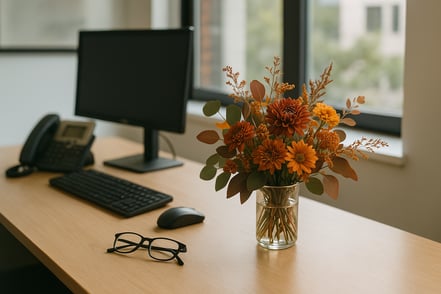For many flower shops, boosting average sales isn’t about finding more customers — it’s about making the most of the ones already calling. The difference between a $75 order and a $125 order is often just one well-phrased suggestion. Yet, many florists hesitate to treat sales skills with the same importance as design skills. By training your staff to guide conversations, you can help customers choose floral designs they’ll love while strengthening your shop’s bottom line.
Step 1: Make the First Impression Count
Every phone call is an opportunity. Customers should feel welcomed the moment you answer. A cheerful, professional greeting like, “All Flowers, this is Sue,” immediately confirms they’ve reached the right place and sets a tone of warmth, trust, and competence. Even if your shop is busy, focus on the caller fully once you’ve answered the call. Be ready to help them. Most orders take only a few minutes, and a friendly voice can mean the difference between gaining a loyal client and losing the sale to another shop.
Step 2: Focus on the Occasion, Not the Price
One of the biggest mistakes florists make is leading with price. Asking, “How much did you want to spend?” diminishes the value of your designs and training. The first step is to verify who is calling so you can access their information easily. Instead, begin the process by asking for the recipient’s name, address, and the message on the enclosure card. This shifts the conversation toward the occasion — an anniversary, birthday, a sympathy order, or a celebration — and helps you suggest arrangements suited to the moment.
If several people are signing the card, use that cue to recommend a higher-end arrangement. For example, “Since this is from your whole family, I’d suggest our Lushly Lavender design. That is available in our deluxe version at $150 or our premium version at $250. It’s elegant and makes a beautiful statement.” Starting with the deluxe and premium options lets customers decide whether they want to spend less, not the other way around.
Step 3: Suggest Add-ons That Matter
Enhancements elevate both the arrangement and the experience. A script helps your team offer them confidently:
“We can add three premium roses for just $18 — it makes the bouquet extra special.”
“This design can go in a heart-shaped vase she’ll keep forever for only $20 more.”
These small upgrades create lasting impressions for the recipient while naturally raising your average order value. Over time, these consistent add-on sales make a significant difference and make the gift more personal in the client’s mind.
Step 4: Use Your Website as a Tool
Today’s customers often reference your website during a call. Train your staff to navigate it quickly so they can confirm designs in real time. If a requested item isn’t available, ask what feature the customer liked most — the pink roses, the style, or the container. With a little flexibility, your staff can guide them toward a comparable or even better design, avoiding lost sales.
The goal is not perfection but confidence. A team that knows how to pivot keeps the customer satisfied, even when substitutions are necessary. It positions them as a professional florist.
Shifting the Mindset
Ultimately, higher average sales aren’t about “selling harder” — they’re about listening carefully, offering thoughtful suggestions, and showing customers what’s possible with price options. Most people want to send something memorable and special. By giving them the option of premium designs and enhancements, you allow them the opportunity to make a better decision for their gift.
When your shop elevates sales conversations from a “transactional style to a consultative approach”, this matches the same level of skill as floral design. You'll find that customers often choose higher-quality gifts on their own. The result? A healthier business, happier customers, and a staff that feels confident and professional in every interaction.
11/7/25 11:22 AM
.png?width=89&height=50&name=Blog%20Design%20(1).png)

